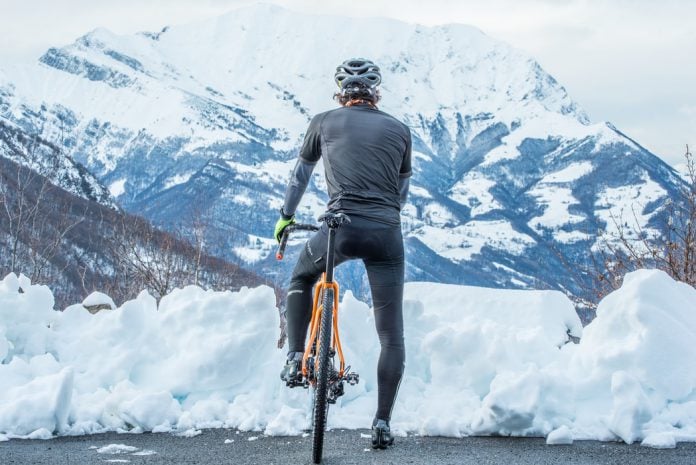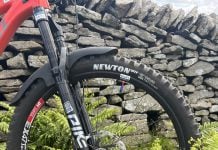Cycling in snow and ice can be a treacherous ordeal. When winter has set in, getting the miles in can be difficult. With a lot of people turning to indoor training and the turbo trainer, there are a hardened few that are out riding no matter the weather. We’ve outlined a few of our top tips to keep you out on the bike when the weather turns.
When the snow comes down in the U.K. pandemonium ensues. Roads are blocked, public transport comes to a halt, people hit the panic button immediately. The chaos that ensues is almost laughable in the UK when the skies open with the soft white stuff.
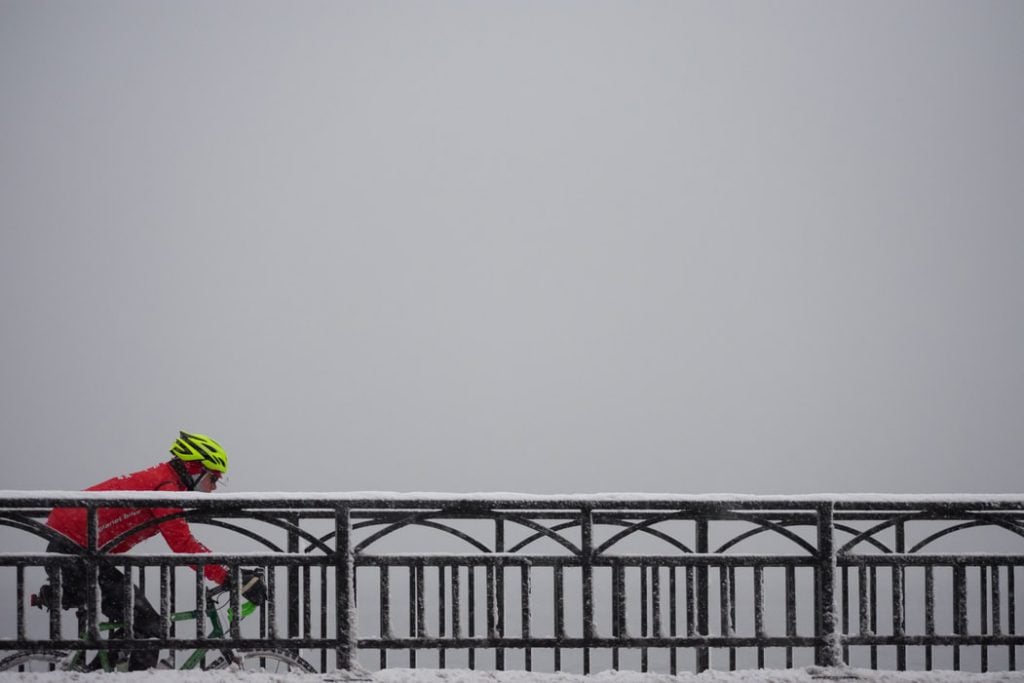
On the surface ditching the car for the bike seems like a reasonable choice. Avoid the traffic, cover some decent ground and still get to work without having to sacrifice holiday. Cycling in the snow should be carefully considered to make sure you’re ready, it’s a risky business!
— HOW TO STAY HYDRATED ON THE BIKE —
Before the Ride
Adjust Tyre Choice
Pick a tyre with more tread if possible. A mountain bike or gravel bike tyre is going to offer you much more tractions than a road bike slick. This is definitely worth bearing in mind when you head out! Studded tyres can offer the maximum grip if you’re cycling in snow.
Maximise Contact
Flatter tyres will mean you have much more surface area in contact with the ground. Running lower pressures and fat tyres is a great starting point for cycling in snow.
Go Tubeless
Tubeless tyres are becoming increasingly popular. One of the main benefits of tubeless is that you can run much lower pressures without the risk of pinch flats. A lot of rims are now tubeless ready, and very easy to set up. Not to be confused with tubular tyres which can be a real headache!
— MOVING FROM FLAT PEDALS – 5 TOP TIPS —

Dress Appropriately
You might think that your brand new short sleeve jersey looks fantastic, although it’s no use wearing it without a base layer, cause you won’t last long! And it’s no use looking fantastic if you’re going to give yourself hyperthermia. You’re only as strong as your weakest point. If you don’t have suitable gloves or shoes/shoe covers, then you might be heading home early to warm them through! Neck warmers/hats can also be great to keep your face warm when you’re really up against it.
Lower Yourself Down
Dropping the saddle slightly is a great way to bring the centre of gravity down. It’ll also bring you closer to the ground if you need to get your feet down for the extra security. Those two long stabilisers attached to your hip can come in incredibly useful if things start going sideways. The added weight can really make all the difference in stopping the back wheel sliding out.
Flat Pedals
Don’t get sucked into the idea that you need to be clipped in to generate power. It’s not quite as efficient, but flat pedals are fine for the majority of riding. They’ll give you an extra safety mechanism if things go wrong!
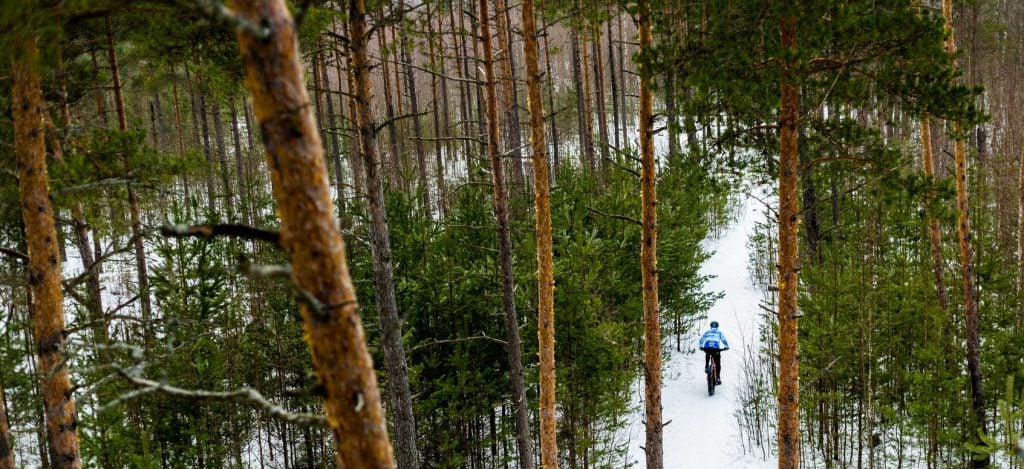
Hands
Winter jackets & thermal leggings aren’t the only thing you’re going to need. Make sure you’re fully stocked up before you head out there on the road, because freezing cold isn’t a nice place to be! It can be dangerous as well as uncomfortable. Make sure you keep your hands warm to have maximum control over the bike if you’re cycling in snow.
Maintain Your Bike
Hose it down, get rid of the grub & at the very least put a bit of oil on it. Checking your brakes are in good order & tires aren’t worn really could save you out on the road. Mechanicals aren’t great at the best of times, but if something fails when you’re descending an icy road, that’s not a situation you want to find yourself in. The salt on the roads acts like an exfoliator for your bike, so make sure you don’t let it wear away at the parts!
During The Ride
Choose The Route Carefully
Stay away from shaded, icy corners on little country lanes. Sticking to larger roads may mean more traffic, but it’ll most likely mean better surfaces and less ice. You need to take care either way, but it’s helpful to have the added security of routes and roads you know won’t be covered in ice from December to February.
— 6 COMMON BIKE PROBLEMS AND THE FIX —
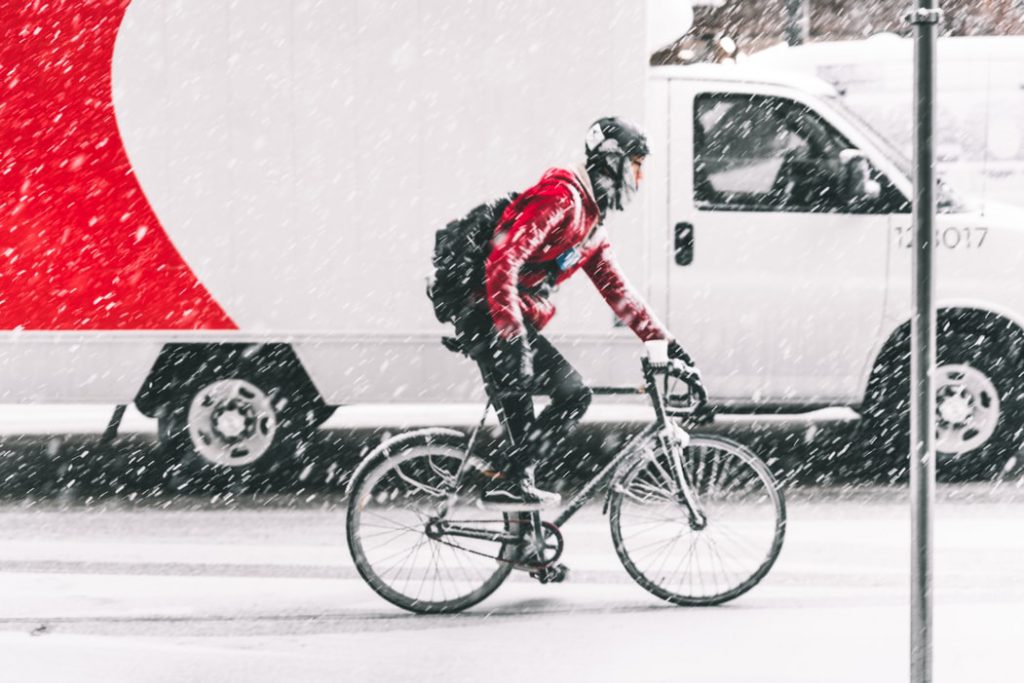
Go Disc
Better in the wet, more control and much better stopping. Disc brakes can really transform winter riding, not to mention how much they’ll save your rims through the darker months. It’s worth looking to move towards a disc brake winter bike.
Pick the Lines
Stay out of trouble by being more careful with the lines you pick. It’s not always easy, but where you’re safe to move away from the edge, pick a dry line.
If you can. The simplest way of avoiding problems when riding on icy roads is to choose the dry line. One recent winter saw very cold but dry weather in much of the country, so the roads weren’t uniformly covered in ice. Instead, it was lying in patches on the road or in gutters, or it was run-off that had frozen across the road so the dry line wasn’t always a straight one. Another year, sticking to the dry line was simply impossible, because compacted snow on untreated roads had just frozen. That’s when you have to cope with actually riding on the ice.
— YOUR GUIDE TO CYCLING KNEE PAIN —
Avoid The Kerb
Even in the height of summer we all know riding close to the kerb comes with it’s challenges. Questionable surfacing, potholes & the odd scrap car part, it’s not ranked highly on the list of best lines to ride. If you have to swerve suddenly this could send your back wheel sliding. On top of that water can congregate at the edges forming little frozen pools. Best to steer clear and position yourself well on a good solid line.
Loosen Off
Make sure you ride relaxed and natural. Too much tension through the body will reflect in your handling of the bike. Smooth and loose is the key!

Riding On Ice
Road Position
As previously mentioned your road position can make all the difference. Probably best not to go round a blind bend on the wrong side of the road just for a dry line, but where it’s safe position yourself away from the edge and on the grippier sections of the road.
Avoid The Front Brake
Well the saying goes “your front brake is to slow you down, your back brake is to stop.” As with every rule, there’s a scenario where it doesn’t really apply. In this case it’s on ice. You want to make sure that you keep maximum traction in the front wheel, if you’re twitchy on the ice and reach for that lever, you could find yourself in trouble!
— BEST FITNESS IMPROVEMENTS YOU CAN BUY —
If you do come across some ice it’s usually best to stay calm and keep your pedal strokes even and smooth. If you really need to take off some speed, try the back brake. If you need to practice find some good fixed gear riders and get them to help you learn to skid with the back wheel, common practice for emergency stops on a fixed gear bike. Don’t be afraid to make the split second decision to put a foot down instead of pedalling through if it’s the right thing to do.
Keep Pedalling Smooth
Nice smooth pedal strokes are the key to cycling in snow and ice. As well as gentle steering, sudden changes of direction with your body weight leaning all over the place is going to cause some real issues. Make sure you keep everything smooth and steady, it’ll make all the difference.
Dismount if Needed
Just because you’re recording for Strava doesn’t mean you can’t dismount and walk. There’s no pride lost by staying upright and walking some slippery sections. Besides, if you have to take 6 weeks off the bike for a broken collarbone, then you won’t be rubbing anyones ego! There’s no dishonour is dismounting.
Don’t Panic
One of the most important. Try to stay calm and think logically throughout. You’ll find it much easier to work out what the best course of action is if you’re calm and controlled. Stay relaxed and go steady. You don’t get any prizes for getting out in the snow and ice, so get yourself a turbo if you must. We want everyone to make it to summer in one piece to enjoy the sunshine!

